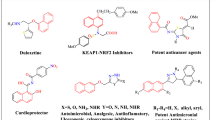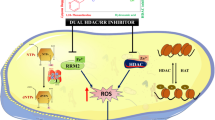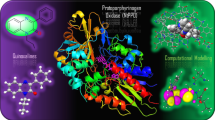Abstract
DNA topoisomerase I (topo I) and II (topo II) are essential enzymes that solve the topological problems of DNA by allowing DNA strands or double helices to pass through each other during cellular processes such as replication, transcription, recombination, and chromatin remodeling. Their critical roles make topoisomerases an attractive drug target against cancer. The present molecular docking study provides insights into the inhibition of topo I and II by curcumin natural derivatives. The binding modes suggested that curcumin natural derivatives docked at the site of DNA cleavage parallel to the axis of DNA base pairing. Cyclocurcumin and curcumin sulphate were predicted to be the most potent inhibitors amongst all the curcumin natural derivatives docked. The binding modes of cyclocurcumin and curcumin sulphate were similar to known inhibitors of topo I and II. Residues like Arg364, Asn722 and base A113 (when docked to topo I-DNA complex) and residues Asp479, Gln778 and base T9 (when docked to topo II-DNA complex) seem to play important role in the binding of curcumin natural derivatives at the site of DNA cleavage.
Similar content being viewed by others
References
Anand, P., Sundaram, C., Jhurani, S., Kunnumakkara, A.B., Aggarwal, B.B. 2008b. Curcumin and cancer: an “old-age” disease with an “age-old” solution. Cancer Lett 267, 133–164.
Anand, P., Thomas, S.G., Kunnumakkara, A.B., Sundaram, C., Harikumar, K.B. et al. 2008a. Biological activities of curcumin and its analogues (Congeners) made by man and Mother Nature. Biochem Pharmacol 76, 1590–1611.
Baird, C.L., Gordon, M.S., Andrenyak, D.M., Marecek, J.F., Lindsley, J.E. 2001. The ATPase reaction cycle of yeast DNA topoisomerase II. Slow rates of ATP resynthesis and P(i) release. J Biol Chem 276, 27893–27898.
Beck, L.S., Deguzman, L., Lee, W.P., Xu, Y., Siegel, M.W., Amento, E.P. 1993. One systemic administration of transforming growth factor-beta 1 reverses ageor glucocorticoid-impaired wound healing. J Clin Invest 92, 2841–2849.
Belani, C.P., Doyle, L.A., Aisner, J. 1994. Etoposide: Current status and future perspectives in the management of malignant neoplasms. Cancer Chemoter Pharmacol 34, 1180–1126.
Champoux, J.J. 2000. Structure-based analysis of the effects of camptothecin on the activities of human topoisomerase I. Ann, N.Y., Acad Sci 922, 56–64.
Champoux, J.J. 2001. DNA topoisomerases: Structure, function, and mechanism. Annu Rev Biochem 70, 369–413.
Chow, K.C., Macdonald, T.L., Ross, W.E. 1988. DNA binding by epipodophyllotoxins and N-acyl anthracyclines: Implications for mechanism of topoisomerase inhibition. Mol Pharmacol 34, 467–473.
Gellert, M. 1981. DNA topoisomerases. Annu Rev Biochem 50, 879–910.
Gupta, E., Mick, R., Ramirez, J., Wang, X., Lestingi, T.M., Vokes, E.E., Ratain, M.J. 1997. Pharmacokinetic and pharmacodynamic evaluation of the topoisomerase inhibitor irinotecan in cancer patients. J Clin Oncol 15, 1502–1510.
Kumar, A., Bora, U. 2011. In silico inhibition studies of NF-κB p50 subunit by curcumin and its natural derivatives. Med Chem Res. doi:110.1007/s00044-011-9873-0.
Lin, J.K. 2007. Molecular targets of curcumin. Adv Exp Med Biol 595, 227–243.
López-Lázaro, M., Willmore, E., Jobson, A., Gilroy, K.L., Curtis, H., Padget, K., Austin, C.A. 2007. Curcumin induces high levels of topoisomerase I- and II-DNA complexes in K562 leukemia cells. J Nat Prod 70, 1884–1888.
Maheshwari, R.K., Singh, A.K., Gaddipati, J., Srimal, R.C. 2006. Multiple biological activities of curcumin: a short review. Life Sci 78, 2081–2087.
Martín-Cordero, C., López-Lázaro, M., Gálvez, M., Ayuso, M.J. 2003. Curcumin as a DNA topoisomerase II poison. J Enzyme Inhib Med Chem 18, 505–509.
Morris, G.M., Goodsell, G.S., Halliday, R.S., Huey, R., Hart, W.E. et al. 1998. Automated docking using Lamarckian genetic algorithm and empirical binding free energy function. J Comput Chem 19, 1639–1662.
Mosieniak, G., Sliwinska, M., Piwocka, K., Sikora, E. 2006. Curcumin abolishes apoptosis resistance of calcitriol-differentiated HL-60 cells. FEBS Lett 580, 4653–4660.
Osheroff, N. 1989. Effect of antineoplastic agents on the DNA cleavage/religation equlibrium of eukaryotic topoisomerase II: Inhibition of DNA religation by etoposide. Biochemistry 28, 6157–6160.
Robinson, H.M., Bratlie-Thoresen, S., Brown, R., Gillespie, D.A. 2007. Chk1 is required for G2/M checkpoint response induced by the catalytic topoisomerase II inhibitor ICRF-193. Cell Cycle 6, 1265–1267.
Salerno, S., Da Settimo, F., Taliani, S., Simorini, F., La Motta, C., Fornaciari, G., Marini, A.M. 2010. Recent advances in the development of dual topoisomerase I and II inhibitors as anticancer drugs. Curr Med Chem 17, 4270–4290.
Sanner, M.F. 1999. Python: a programming language for software integration and development. J Mol Graph Model 17, 57–61.
Staker, B.L., Hjerrild, K., Feese, M.D., Behnke, C.A. et al. 2002. The mechanism of topoisomerase I poisoning by a camptothecin analog. PNAS 99, 15387–15392.
Wang, J.C. 1985. DNA topoisomerases. Annu Rev Biochem 54, 665–697.
Wang, J.C. 2002. Cellular roles of DNA topoisomerases: A molecular perspective. Nat Rev Mol Cell Biol 3, 430–440.
Author information
Authors and Affiliations
Corresponding author
Rights and permissions
About this article
Cite this article
Kumar, A., Bora, U. Molecular docking studies of curcumin natural derivatives with DNA topoisomerase I and II-DNA complexes. Interdiscip Sci Comput Life Sci 6, 285–291 (2014). https://doi.org/10.1007/s12539-012-0048-6
Received:
Revised:
Accepted:
Published:
Issue Date:
DOI: https://doi.org/10.1007/s12539-012-0048-6




